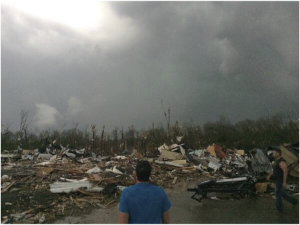| Section |
|---|
| Column |
|---|
IntroductionThis page describes two studies of convection with different convective casescharacteristics; one over N. America associated with the formation of severe tornadoes, the other over central Africa. The N.America case has strong large scale forcing whereas the central African case is driven by the diurnal cycle. Both cases are studied starting the use a forecast from the same date/time (initial conditions). In these case studies, you will carry out a control forecast, followed by any number of suggested sensitivities sensitivity experiments. | Info |
|---|
These case studies were used in the 2014 OpenIFS user workshop at the University of Stockholm.
A Linux 'virtual machine' with a complete copy of the Stockholm workshop exercises is available on request from openifs-support@ecmwf.int.
For more details and copies of handouts, please see the workshop page. |
US Tornado convection case (Arkansas) On the 27 April 7pm local time (00UTC 28 April), tornadoes hit towns north and west of Little Rock, Arkansas killing approx 17 people. people (see http://edition.cnn.com/2014/04/28/us/severe-weather/index.html?hpt=hp_c2). On the evening on the 28 April fatal tornadoes occurred over Mississippi ( see: http://www.bbc.co.uk/news/world-us-canada-27199071). This case study will look at the role of convection and the large scale in these events.
More information can also be found on the ECMWF Severe Event Catalogue 201404 - Convection - Arkansas U.S.
| Panel |
|---|
| borderColor | white |
|---|
| bgColor | white |
|---|
| titleBGColor | white |
|---|
|   |
African diurnal deep convection (Central Africa)Over tropical land masses, incoming radiation strongly heats the surface leading to the development of deep convection and precipitation. Observations show that convective activity and precipitation peak in the late afternoon or early evening. Until very recently, numerical weather prediction models struggled to reproduce this diurnal cycle, often predicting convection to peak too early in the day. In this case study, aspects of the convective parameterization scheme can be altered to see how the intensity and the diurnal cycle of convection responsesresponds. |
| Column |
|---|
| Panel |
|---|
| bgColor | white |
|---|
| titleBGColor | #dcf0f7 |
|---|
| borderStyle | dotted |
|---|
| title | On this page... |
|---|
| |
| Info |
|---|
Note that if using OpenIFS version 38r1 needs some additional code is needed for the diurnal correction of convection case study. |
|
|
Initial conditions
Case study initial conditions for this case study are provided on the OpenIFS ftp site.
The initial conditions are available at a range of different resolutions and start dates for a 30hr forecast. The experiment ids are created at ECMWF and used for identifying the model forecasts on the ECMWF archive system (for those with access).
Note that All of the initial data provided are derived from ECMWF operational analyses (not ERA-Interim has a resolution of T255). These operational analyses use a horizontal resolution of T1279 and 137 vertical levels. Lower resolutions are spectrally fitted and interpolated to produce balanced initial conditions.
| Info |
|---|
As OpenIFS is a spectral model, the 'T' number refers to the triangular truncation in spectral space. Equivalent grid resolutions are:
T159 ~ 125km resolution, T255 ~ 80km, T511 ~ 40km, T799 ~ 25km, T1279 ~ 16km. |
...
The number of vertical levels is given after the letter 'L' e.g. L62 means 62 vertical levels. Please note that higher resolutions progressively require more processors and computer memory to run. |
| Panel |
|---|
| borderColor | gray |
|---|
| bgColor | white |
|---|
| titleBGColor | #e0e0e0 |
|---|
| borderStyle | dotted |
|---|
| title | Available start dates |
|---|
|
| Section |
|---|
| Column |
|---|
| | Resolution | Expt id | Start dates | Filename | File size |
|---|
| T159L62 | g4a5 | 2014/04/22 at 00Z | t159l62_g4a5_2014042200.tgz | 19Mb | | | | 2014/04/27 at 00Z | t159l62_g4a5_2014042700.tgz | 19Mb | | T255L62 | g4a4 | 2014/04/22 at 00Z | t255l62_g4a4_2014042200.tgz | 51Mb | | | | 2014/04/27 at 00Z | t255l62_g4a4_2014042700.tgz | 51Mb | | T255L91 | g455 | 2014/0427 at 00Z | t255l91_g455_2014042700.tgz | 76Mb | | T511L62 | gflf | 20140422 at 00Z | t511l62_gflf_2014042200.tgz | 190Mb | | | | 20140427 at 00Z | t511l62_gflf_2014042700.tgz | 190Mb | | T1023L60 | fs2y | 1999/12/24/12z | T1023_1999122412_fs2y.tgz | 780Mb | | T1279L60 | fqaf | 1999/12/24/12z | T1279_1999122412_fqaf.tgz | 1.2Gb |
|
| Column |
|---|
| Info |
|---|
To unpack files with .tgz, either use: tar zxf T159_1999122412_fqar.tgz
or if your tar command does not support compression: mv T159_1999122412_fqar.tgz T159_1999122412_fqar.tar.gz
gunzip T159_1999122412_fqar.tar.gz
tar xf T159_1999122412_fqar.tar
|
|
|
|
Download instructions
| Code Block |
|---|
|
% mkdir -p runs/convection/t255
% cd runs
% ftp ftp.ecmwf.int
ftp> cd case_studies/lothar_storm
ftp> binary
ftp> get 1999122412_T159_fqar.tgz
ftp> quit
% tar zxf 1999122412_T159_fqar.tgz
% ls
1999122412_T159.tgz ICMCLfqarINIT ICMGGfqarINIT ICMGGfqarINIUA ICMSHfqarINIT ecmwf
% ls ecmwf
NODE.001_01 namelistfc |
...
